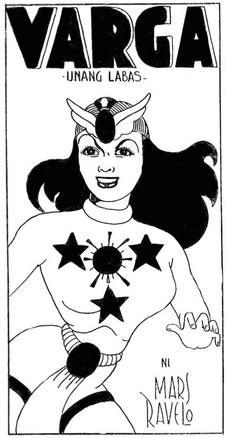Varga (comics)
| Varga | |
|---|---|

Upon a shout and a touch, the violet-colored ghost Vara unites with the human child Olga, fused into one person in a single body: the superheroine Varga (Vara + Olga).
|
|
| Publication information | |
| Publisher | Bulaklak Magazine |
| First appearance | 1947 |
| Created by | Mars Ravelo |
| In-story information | |
| Alter ego | Darna; Princess Vara; Olga |
| Species | Alien |
| Place of origin | Planet Vargon; Earth |
| Abilities | flight |
Varga is a Filipino comics superheroine, similar to the American Wonder Woman. Mars Ravelo wrote and illustrated Varga for Bulaklak Magazine, appearing first on the magazines No. 17, Vol. 4 (July 23, 1947) issue. A falling out with some of the magazines editors caused him to resign from Bulaklak and transfer to Pilipino Komiks (Ace Publications), where he re-launched his superhero. Ravelo renamed her Darna, anagram of the superheroine's mortal alter-ego Narda. Darna's adventures in Pilipino Komiks began on the No. 77 (May 13, 1950) issue. Another komiks legend, Nestor Redondo, illustrated Darna this time.
Not to be confused with the similarly named Edwin Samonte character, Varga: The Amazing Iron Lady (first appearance on Super Action Komiks, No.191, April 11, 1989).
Mars Ravelo (1916–1988) was one of the most successful Filipino comics artists. He was the creator of the famous superheroine 'Darna', and the highest paid comics artist of his time. It can also be noted that Varga was a character archived twice. First, Varga began as a superheroine concept before World War II/late 1939. Ravelo, a then young pioneering illustrator from Tanza, Cavite, thought of creating a female counterpart for Superman because he believed in the concept that the US is “male” and the Philippines is “female.” He didn’t want to use the term “Superwoman” so as not to plagiarize the Siegel and Shuster creation. So instead as inspired by Superman, Mars Ravelo originally referred to his superheroine as "Kamangha-manghang dilag" (The Amazing Warrior Maiden) and combined the superhuman qualities of Superman with his own real life hero--his mother. Mars, a young and struggling cartoonist then, brought his superheroine idea as the Philippines’ answer to Superman to various publications both in the Philippines and in the United States but was rejected because publishers kept telling him "female superheroes will not sell". So Ravelo shelved his concept for the duration of the war. Years after the war, Ravelo realized the Filipinos were in need of a superhero so he again shopped his superheroine concept to publishers until one of them, Bulaklak Komiks ("Flower Comics") agreed to publish Ravelo's heroine that he now called "Varga" in 1947 (inspired by the Varga Girls series of illustrations) and the strip took off. VARGA made her debut in Bulaklak Magazine, Vol. 4, #17 on July 23, 1947 which Mars both wrote and drew himself. Second, when the name Varga became the ownership of Bulaklak magazine (during those times, intellectual property right is not yet in effect) and when Ravelo left the publication in 1949 after a falling out with its editor, Varga stayed behind. So, upon joining Pilipino Komiks in 1949, he rebuilt 'Varga' to 'Darna'. The character soon appeared in Kenkoy, Liwayway and Kampeon Comics and eventually got her own title as well as a series of movie and TV adaptations. It was under the name "DARNA" that this Ravelo creation would become famous for.
...
Wikipedia
